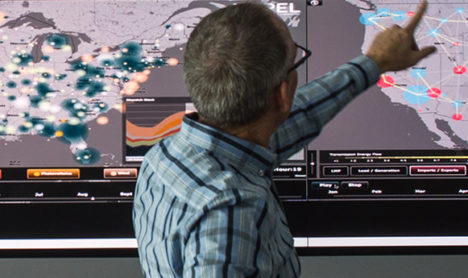
Publications
-

Energy Efficiency Jobs in America – 2024
By E4TheFuture and Building Performance Association – November 2024
Energy efficiency employed nearly 2.3 million Americans in 2023. This eighth annual report provides a visually rich summary of U.S. efficiency jobs and a full report offering state-by-state comparisons by sector, technology, firm size, jobs by county and legislative district, and more.The report and its dedicated website with animated key statistics is based on data from the U.S. Bureau of Labor Statistics and a survey of 42,100 businesses, using a methodology developed for the U.S. Department of Energy.
Download full report, National Summary, and State-Level Resources
-
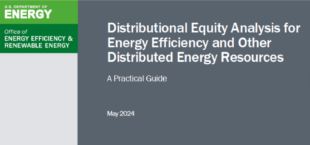
Distributional Equity Analysis for Energy Efficiency and Other Distributed Energy Resources
Published by U.S. Dept. of Energy (Berkeley Lab) – May 2024
E4TheFuture co-funded Distributional Equity Analysis for Energy Efficiency and Other Distributed Energy Resources: A Practical Guide. Designed for state energy regulators and key stakeholders to help inform equity implications of DER investment decisions. See context and related collateral (Framework Summary and Engagement Guide) at National Energy Screening Project.
Primary Authors: Tim Woolf, Alice Napoleon, Danielle Goldberg, Ellen Carlson, Chelsea Mattioda, Elijah Sinclair and Camille Minns of Synapse Energy Economics. Contributing authors: Natalie Mims Frick and Lisa Schwartz of Berkeley Lab, and Julie Michals, E4TheFuture. The Building Technologies Office of the U.S. DOE Office of Energy Efficiency and Renewable Energy also supported publication.
-
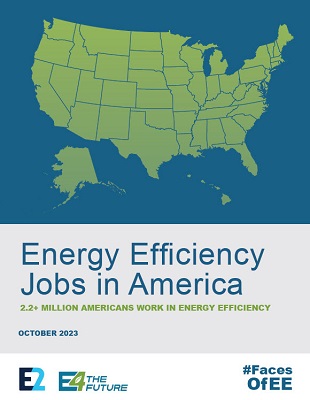
Energy Efficiency Jobs in America – 2023
By E4TheFuture and E2 – October 2023
Energy efficiency employed more than 2.2 million Americans in 2022. This seventh annual report provides a visually rich summary of U.S. efficiency jobs and a full report offering state-by-state comparisons by sector, technology, firm size, jobs by county and legislative district, and more. Workforce development, equity considerations, and policy recommendations are illuminated.The report and its dedicated website with animated key statistics is based on data from the U.S. Bureau of Labor Statistics and a survey of 34,200 businesses, using a methodology developed for the U.S. Department of Energy.
Download full report
Download national summary
Download state fact sheets -
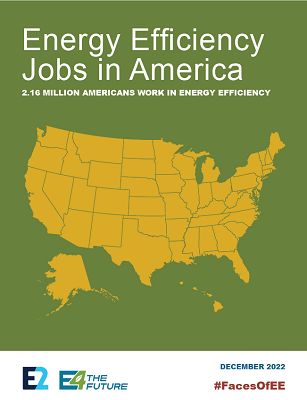
Energy Efficiency Jobs in America – 2022
By E4TheFuture and E2 – December 2022/January 2023
Energy efficiency employed more than 2.16 million Americans in 2021. Spurred by historic federal infrastructure investment, the sector is poised for spectacular growth. This sixth annual report provides a summary of U.S. efficiency jobs, plus a full report offering state-by-state comparisons by sector, technology, firm size and more. Workforce development, equity considerations, and policy recommendations are discussed.The report and its dedicated website with animated key statistics is based on data from the U.S. Bureau of Labor Statistics and a survey of 33,000 businesses, using a methodology developed for the U.S. Department of Energy.
January update: County-level data added
Download full report
Download national summary
Download state fact sheets -
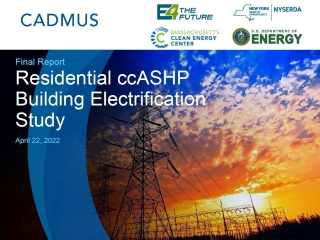
Residential ccASHP Building Electrification Study
Authored by Cadmus – Spring 2022
E4TheFuture co-funded a Cold Climate Air Source Heat Pump Building Electrification Study, researching ccASHP systems in over 40 homes that use ccASHP systems as their primary heating source, designed for whole-home heating and cooling. A Cadmus project team collected in-field metered data across Massachusetts and New York (Fall 2020 through Fall 2021). The resulting analysis culminated in an in-depth study assessing customer satisfaction, system utilization, heating load, and performance during a typical Northeast winter.
Co-funders and collaborators: the Massachusetts Clean Energy Center (MassCEC), the New York State Energy Research and Development Authority (NYSERDA), and the U.S. Department of Energy’s Building Technologies Office.
-

Benefit-Cost Analysis Case Studies: Examples of Distributed Energy Resource Use Cases
By the National Energy Screening Project – June 2022
Coordinated/funded by E4TheFuture and authored by Smart Electric Power Alliance with technical/modeling support from ICF, this compendium to the National Standard Practice ManualTM comprises three case studies that illustrate benefit-cost analyses (BCAs) for distributed energy resource (DER) technologies and use cases of growing interest in the electric industry.
The compendium includes:
• Residential EV Managed Charging in the Midwest
• Commercial Solar + Storage Controlled Dispatch in the West
• Residential Grid-interactive Efficient Building Retrofit in the Mid-AtlanticEach is informed by real-world BCAs and data for similar use cases, generalized into examples for broader applicability and based on cost-effectiveness tests that align with specific policy goals and objectives for hypothetical jurisdictions.
-
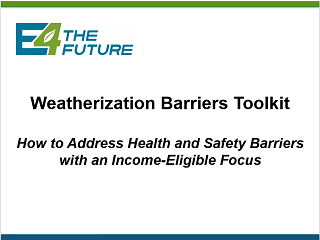
Weatherization Barriers Toolkit: How to Address Health and Safety Barriers with an Income-Eligible Focus
Prepared by Elizabeth Bourguet and Richard Faesy (Energy Futures Group) and Ellen Tohn (Tohn Environmental Strategies) – April 2022; updated June 2022
Funded by E4TheFuture, this toolkit document articulates “lessons learned” from Connecticut’s process 2014-22 as the state sought to address health and safety barriers in low-income homes to enable participation in the federally-funded Weatherization Assistance Program and the utility-funded Home Energy Solutions Income-Eligible Program. It provides an overview of challenges that health and safety barriers create, and guidance for overcoming them. -> Get updated slides and see a list of resources.
-
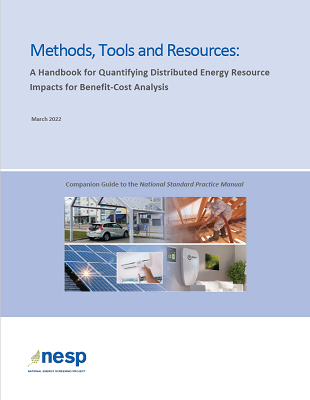
Methods, Tools and Resources: A Handbook for Quantifying Distributed Energy Resource Impacts for Benefit-Cost Analysis
By the National Energy Screening Project – March 2022 / June 2022
Coordinated/funded by E4TheFuture and authored by a project team comprising staff from Synapse Energy Economics (primary), Parmenter Consulting, Apex Analytics and Energy Futures Group with over 20 reviewers from prominent organizations; the 250+ page “MTR handbook” is a companion document to the National Standard Practice ManualTM.
The handbook provides extensive technical information on how benefits and costs of DER investments can be quantified (monetized or otherwise), with links to resources and tools. It is intended as a reference guide for anyone preparing a BCA for DERs including utilities, regulators and regulatory staff, state energy offices, evaluators, practitioners, consultants, and stakeholders in the DER regulatory process. It offers guidance for parties that review, critique, and comment on BCAs.
In June 2022, NESP added a new way to access the entire handbook, including minor updates.
View Online -
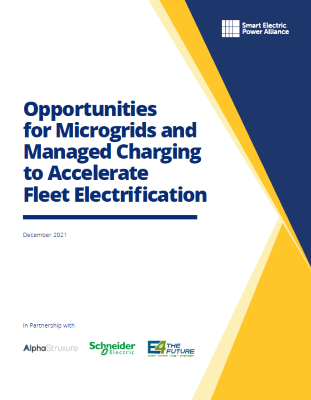
Opportunities for Microgrids and Managed Charging to Accelerate Fleet Electrification
By Smart Electric Power Alliance (Mac Keller, Jared Leader, Garrett Fitzgerald) – December 2021
E4TheFuture provided funding for SEPA’s brief that synthesizes findings and action items from a workshop comprising participants from utilities, solution providers, fleet operators, and auto OEMs to understand barriers and opportunities related to microgrids and managed charging for fleet vehicles. Providing a stakeholder, technology, and regulatory perspective, the 12-page document offers guidance for fleet operators, utilities, and solution providers to streamline infrastructure deployment.
-
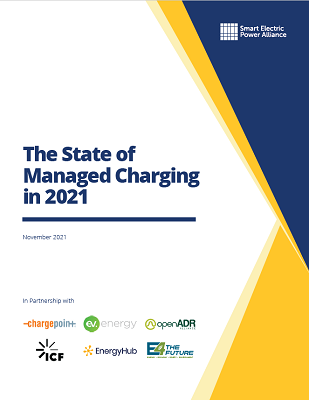
The State of Managed Charging in 2021
By Smart Electric Power Alliance (Brittany Blair, Garrett Fitzgerald, Carolyn Dougherty) – November 2021
E4TheFuture provided funding for SEPA’s report that offers seven case studies demonstrating the evolving size and sophistication of managed charging programs. Utility survey results provide insights into technologies, vendor capabilities and best practices. The report describes a shift from passive to active programs, the growing interest in vehicle-to-grid (V2G) and vehicle telematics, and an increasing focus on customer participation.
-
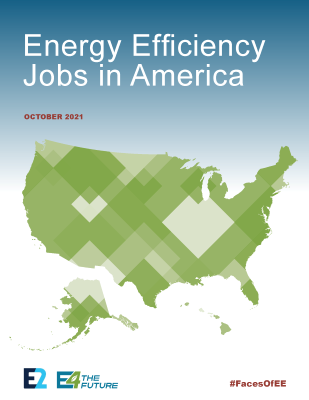
Energy Efficiency Jobs in America – 2021
By E4TheFuture and E2 – October 2021
Energy efficiency employed more than 2 million Americans in 2020 and through the first half of 2021, dominating the U.S. clean energy economy–yet far behind what is needed for the energy transition. This fifth annual report provides a 13-page summary of 2020-21 U.S. efficiency jobs badly impacted by the pandemic. State specifics in the full report’s 400+ pages offer comparisons by sector, technology, firm size and more with job numbers by metro, county, legislative and congressional districts. Workforce development and training, career paths and policy recommendations are discussed.
The report and its dedicated website with animated key statistics is based on data from the U.S. Bureau of Labor Statistics and a late-2020 survey of 35,000 businesses, using a methodology developed for the U.S. Department of Energy. Additional research was provided by BW Research Partnership.
Download full report
Download national summary
Download state fact sheets -
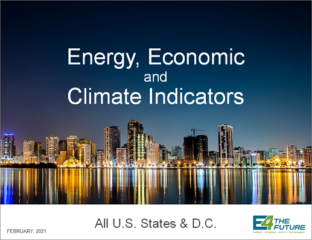
Energy, Economic and Climate Indicators
Per capita, for all U.S. states and the District of Columbia
Source materials prepared for E4TheFuture by Synapse Energy Economics, Inc. – February, 2021
Since 1990, the United States produced robust economic output while lowering energy use and emissions. Tracking publicly available metrics over time helps us assess public policies’ impact at national and state levels. This set of graphs demonstrates a nearly 30-year trend, while providing a means to compare and contrast results at the state level. Investing in energy efficiency and clean energy has significantly boosted economic growth and contributed to economic equity and long term health improvements.
-
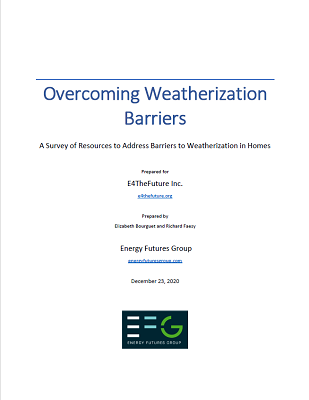
Overcoming Weatherization Barriers: A Survey of Resources to Address Barriers to Weatherization in Homes
Prepared by Elizabeth Bourguet and Richard Faesy, Energy Futures Group – December 2020
E4TheFuture asked Energy Futures Group to develop a review of currently operating programs that address barriers to weatherizing homes, and a set of recommendations pertaining to accessibility, funding, and improved health. The white paper offers details and suggestions specific to Connecticut, which is exploring options for barrier mitigation. It calls attention to the connection between energy conservation and home health efforts.
Improving homes to remediate mold, asbestos, or lead paint, makes homes safer and enables weatherization services to commence. This paper examines program elements, gathers data on program use, and provides lessons learned. A sortable resources matrix offers a deeper review of existing programs in the Northeast, and national scope resources.
Download the paper.
Download Workshop Slides (Connecticut, Nov. 2020)
Download Resources Matrix. -
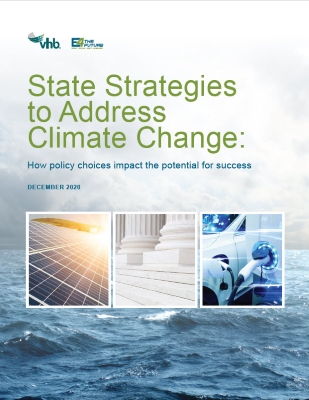
State Strategies to Address Climate Change: How Policy Choices Impact the Potential for Success
By VHB (Scott Johnstone) – December 2020
E4TheFuture commissioned a report focused on approaches used in the United States to address climate change. Fifteen states are examined in this “snapshot in time”: California, Colorado, Hawaii, Maryland, Massachusetts, Minnesota, New Jersey, New Mexico, Nevada, New York, Oregon, Pennsylvania, Vermont, Virginia, and Washington. State strategies emphasize the adoption of clean energy policy, but vary considerably in their specifics. This report enables an understanding of how progress may be made in any state by seeing what is possible today.
-
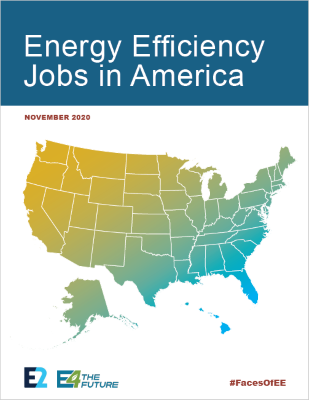
Energy Efficiency Jobs in America – 2020
By E4TheFuture and E2 – November 2020
Energy efficiency employed nearly 2.4 million Americans in 2019, by far the most in the U.S. clean economy. This fourth annual publication begins with an 11-page national summary of the 2019-20 efficiency jobs landscape including the pandemic’s impact. State specifics fill out the full report’s 430 pages with meaningful comparisons such as sectors, technologies, firm size and more. Job numbers are detailed for metro, county, legislative and congressional districts.
The report and its dedicated website with animated key statistics is based on data from the U.S. Bureau of Labor Statistics and a late-2019 survey of tens of thousands of businesses, using a methodology developed for the U.S. Department of Energy. Additions for this year’s report include monthly 2020 unemployment analyses by BW Research Partnership and additional research conducted by E4TheFuture in collaboration with E2 and other organizations.
Download full report
Download national summary
Download state fact sheets -
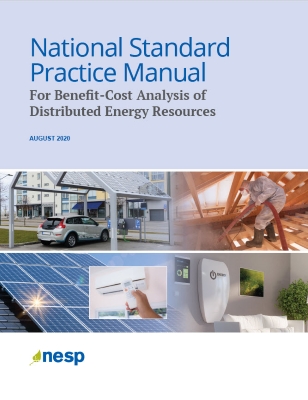
National Standard Practice Manual
By the National Energy Screening Project (NESPTM) – August 2020
Coordinated by E4TheFuture and authored by a team of benefit-cost analysis experts, the National Standard Practice ManualTM (NSPM) provides a comprehensive framework for cost-effectiveness assessment of distributed energy resources, including energy efficiency.
This guidance document provides a set of policy-neutral, non-biased, and economically-sound principles, concepts, and methodologies to support single- and multi-DER benefit-cost analysis (BCA) for: energy efficiency (EE), demand response (DR), distributed generation (DG), distributed storage (DS), and (building and vehicle) electrification. The manual is intended for use by jurisdictions to help inform which resources to acquire to meet the jurisdiction’s specific policy goals and objectives. The document incorporates and builds upon the 2017 NSPM for EE.
-
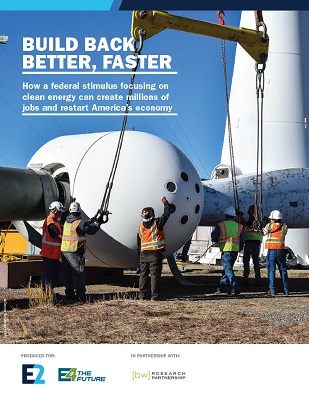
Build Back Better, Faster
By E2, E4TheFuture, and BW Research Partnership – July 2020
Build Back Better, Faster: How a federal stimulus focusing on clean energy can create millions of jobs and restart America’s economy focuses on existing, funding-approved programs in three areas: renewable energy, energy efficiency and grid modernization.
This analysis shows how $99.2 billion of federal investment in existing programs can quickly return unemployed clean energy workers to every state and add $66 billion to the nation’s economy every year for five years. Modeled results–$330 billion in wages, local, state, and federal tax revenues and other economic benefits–more than triple the amount invested. Multipliers are pulled from Emsi, a labor force analytics and economic modeling tool.
-
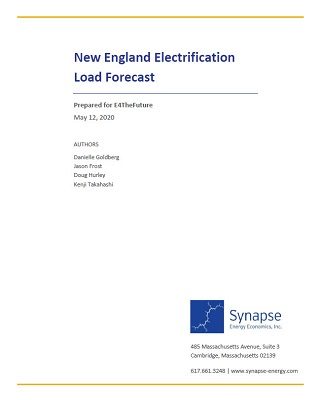
New England Electrification Load Forecast
Authored by Danielle Goldberg, Jason Frost, and Doug Hurley of Synapse Energy Economics, Inc. – May 2020
On behalf of E4TheFuture, Synapse developed an independent forecast of electrification impacts on New England’s electric grid with Low, Mid, and High scenarios.
New England states have set goals to reduce carbon dioxide emissions drastically. The goals will require electrification of end uses currently powered by fossil fuels. Heating systems and transportation will change, increasing electric load. The study identified that climate goals will not be reached without significantly higher electrification strategies than those currently in place.
Synapse authors found that policymakers can set an ambitious path to meet climate goals without significant disruption to the electric grid, by incorporating updated EV charging rates and controls. By continuing to offer efficiency programs, states can mitigate or even eliminate grid impacts due to electrification.
-
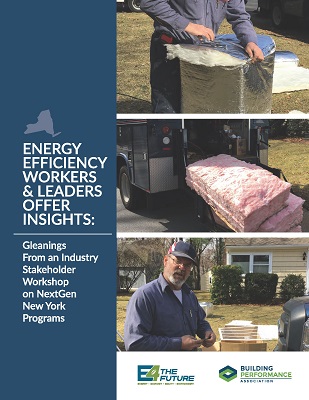
Energy Efficiency Workers and Leaders Offer Insights: Gleanings From an Industry Stakeholder Workshop on NextGen New York Programs
By E4TheFuture and the Building Performance Association – March 2020
This report details essential feedback from a New York Contractor and Industry Allies Workshop convened by E4TheFuture and the Building Performance Association on February 10, 2020. In the weeks following the Workshop, a major crisis emerged in New York and elsewhere, as COVID-19 spread rapidly. Extreme impacts on companies and workers–including home performance and weatherization contractors–are unfolding as allies attempt to mitigate the worst impacts.
Issues raised and consensus positions developed at the Workshop will be important to help the energy efficiency/building performance industry regain strength when the state of emergency is lifted.
-
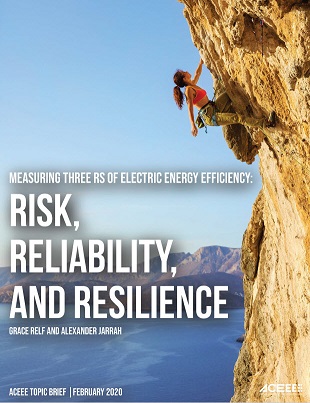
Measuring Three Rs of Electric Energy Efficiency: Risk, Reliability, and Resilience
By the American Council for an Energy-Efficient Economy (Grace Relf and Alexander Jarrah) – February 2020
E4TheFuture provided support for a topic brief on quantifying risk, reliability, and resilience (“three Rs”). Why? Because very few program administrators currently account for these impacts in their benefit-cost analyses of efficiency resources. With fires and severe storms causing billions of dollars in damage annually plus uncertainties around future fuel/related avoided costs, it is necessary to consider – and account for – the benefits of energy efficiency (and other distributed energy resources) associated with the three Rs.
Energy efficiency offers crucial grid stability and resilience to balance supply and demand from increasing investment in renewable power generation. This brief explores how stakeholders can quantify three Rs in their cost-effectiveness tests for energy efficiency.
-
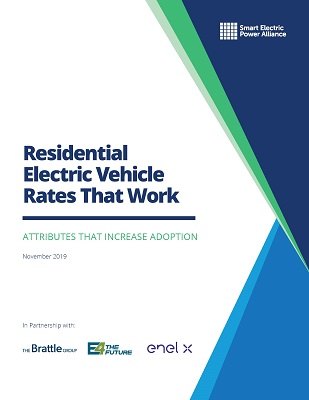
Residential Electric Vehicle Rates That Work: Attributes That Increase Adoption
By Smart Electric Power Alliance (Erika H. Myers, Jacob Hargrave, Richard Farinas), Enel X (Lauren Burke), and The Brattle Group (Ryan Hledik) – November 2019
E4TheFuture funded a report from Smart Electric Power Alliance (SEPA) on residential EV time-varying rates that limit system peaks, which shows how EV-specific rates are more effective than generic utility time-of-use rates. EV time-varying rates effectively incentivize off-peak charging, and customers are interested in using them. Utilities are faced with an urgent need to avoid costly distribution system impacts and infrastructure upgrades; this report will help to inform a smart approach to encourage off-peak residential charging. The report provides empirical evidence on factors that increase enrollment, based on the most comprehensive EV rate surveys to-date of EV customers and utilities.
-
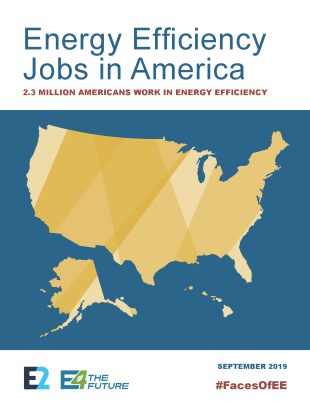
Energy Efficiency Jobs in America – 2019
By E4TheFuture and E2 – September 2019 [NOTE: This report is historical / superseded by newer versions.]
Energy efficiency employs more than 2.3 million Americans, by far the most in the U.S. clean economy. Rich in visual content, this third annual publication begins with a seven-page summary that provides an overview highlighting the top ten states for jobs and for job growth. Meaningful comparisons include sectors, technologies, firm size and more. Detailed state fact sheets also provide efficiency job numbers for metro, county, legislative and congressional districts and introduce Faces of EE.
The report is based on data from the U.S. Bureau of Labor Statistics and a comprehensive survey of tens of thousands of businesses, using a methodology developed for the U.S. Department of Energy.
-
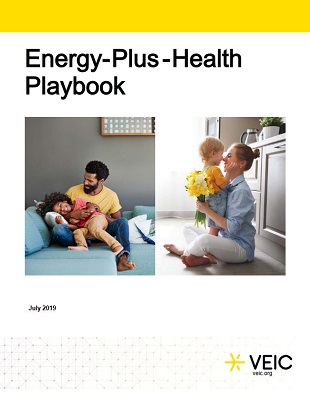
Energy-Plus-Health Playbook
By VEIC (Laura Capps, Liz Curry, Emily Levin) – July 2019
E4TheFuture funded development of this groundbreaking playbook, designed primarily to support energy efficiency program administrators with interests and opportunities in integrated energy and health programs. The Energy-Plus-Health Playbook outlines three program tiers with increasing levels of health and energy integration. It illuminates key case studies and considerations for program design and/or development, as well as tips for navigating partnerships with the health industry, and tools and resources for implementing integrated programs. For general information about our work in this area, see Energy Plus Health.
-
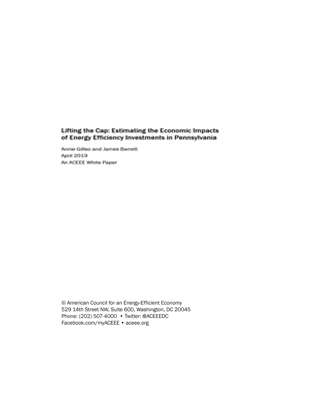
Lifting the Cap: Estimating the Economic Impacts of Energy Efficiency Investments in Pennsylvania
By the American Council for an Energy-Efficient Economy (Annie Gilleo and James Barrett) – April 2019
E4TheFuture provided support for a report that analyzes the job-creation impacts of increased energy efficiency investments from electric distribution utilities in the Commonwealth of Pennsylvania. The authors found that under current Pennsylvania law, efficiency investments are artificially capped, limiting energy savings and associated economic benefits. Unconstrained investments could create more than 30,000 jobs, a 50% increase.
-
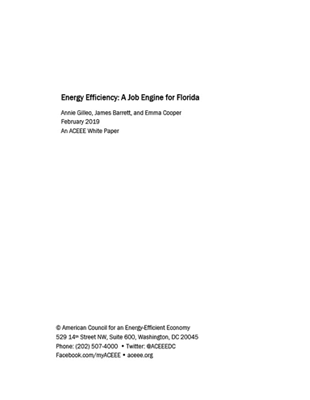
Energy Efficiency: A Job Engine for Florida
By the American Council for an Energy-Efficient Economy (Annie Gilleo, James Barrett, and Emma Cooper) – February 2019
E4TheFuture provided support for a white paper on five key energy efficiency policies that Florida can adopt to spur job growth across the state. These include setting energy efficiency targets for utilities, adopting state-level appliance standards, promoting the use of combined heat and power, updating building energy codes, and working with cities to benchmark large public and commercial buildings. For each policy, the authors examine job creation potential, offer examples of successful implementation, and outline practical steps for adoption. Potential economic impacts of electric vehicle adoption are also discussed.
-
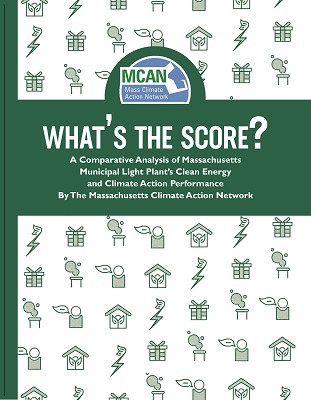
What’s the Score?
A Comparative Analysis of Massachusetts Municipal Light Plants’ Clean Energy and Climate Action Performance
By The Massachusetts Climate Action Network – January 2019
Co-funded by E4TheFuture, the Barr Foundation and the Putnam Family Foundation, this first-ever “report card” provides a valuable analysis of how well the Commonwealth’s 41 municipal electric utilities are doing with clean energy supply portfolios, energy efficiency programs, transparency to customers, and future plans.
-
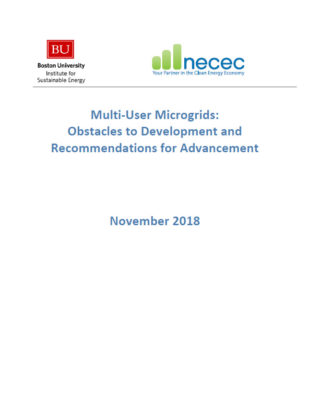
Multi-User Microgrids: Obstacles to Development and Recommendations for Advancement
By NECEC Institute and the Boston University Institute for Sustainable Energy – November 2018
E4TheFuture provided support for a white paper on multi-user microgrid deployment, focusing primarily on the northeast United States. The paper explores seven key barriers limiting multi-user microgrid development, as well as potential solutions. Professor Kira Fabrizio of the Questrom School of Business at Boston University served as the principal investigator for BU on this research.
-
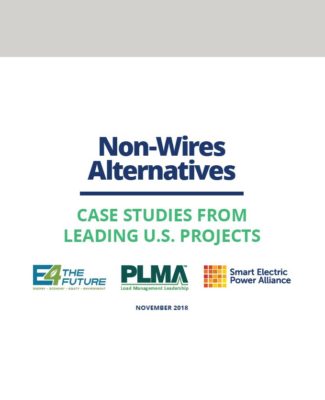
Non-Wires Alternatives: Case Studies from Leading U.S. Projects
By E4TheFuture, Smart Electric Power Alliance (SEPA), and Peak Load Management Alliance (PLMA) – November 2018
This report documents 10 non-wires alternatives (NWAs) projects across the U.S. Details are provided on critical insights each project offers for utilities and other project developers.
As models evolve to meet electricity needs without adding transmission lines, increasing use of energy efficiency, demand response, solar, storage and microgrids can bring value as least-cost energy solutions. Using NWAs to delay or defer the need for comparably more expensive infrastructure is a useful approach.
-
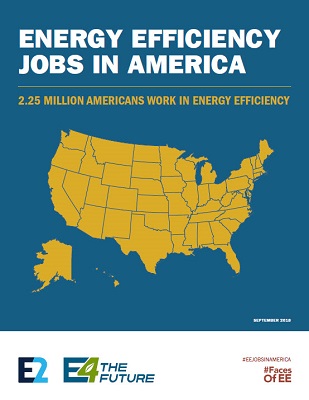
Energy Efficiency Jobs in America – 2018
By E4TheFuture and E2 – September 2018 [NOTE: This report is historical / superseded by newer versions.]
Energy efficiency employs 2.25 million Americans, by far the largest sector in the U.S. clean economy. This report provides an overview that highlights the top ten states and gives meaningful comparisons. More importantly, it includes detailed state fact sheets with energy efficiency job numbers on city, county, legislative and congressional district levels.
The report is based on data from the U.S. Bureau of Labor Statistics and the U.S. Department of Energy, as well as a comprehensive survey of tens of thousands of businesses across the country.
-

Massachusetts Micro-Business Research
Executive summary prepared for E4TheFuture by Acadia Consulting – May, 2018
Research conducted in 2018 provides insights into attitudes and behaviors around energy saving opportunities for micro-business owners in Massachusetts utility program territories. Although individually these operations are very small energy users, collectively the category represents a large proportion of businesses in the Commonwealth.
-
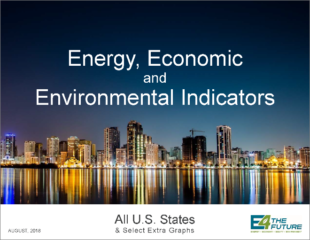
Energy, Economic and Environmental Indicators
Including all U.S. states
Source materials prepared for E4TheFuture by Synapse Energy Economics, Inc. – August, 2018
Since 1990, the United States produced robust economic output while lowering energy use and emissions. Tracking publicly available metrics over time helps us assess public policies’ impact at national and state levels. This set of graphs demonstrates a twenty-five year trend, while providing a means to compare and contrast results at the state level. Investing in energy efficiency and clean energy has significantly boosted economic growth and contributed to economic equity and long term health improvements.
-
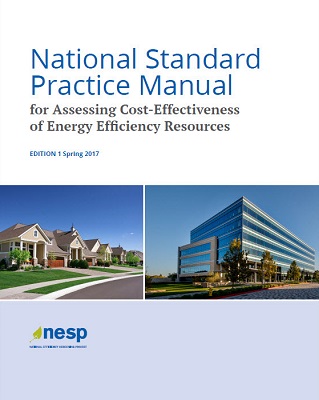
National Standard Practice Manual – NSPM for EE
By the National Efficiency Screening Project – May 2017
Authored by Tim Woolf, Chris Neme, Marty Kushler, Steve Schiller, and Tom Eckman, the National Standard Practice Manual for Energy Efficiency (NSPM for EE) provides a comprehensive framework for cost-effectiveness assessment of energy resources, with a focus on energy efficiency. The manual describes principles, concepts, and methodologies for sound, balanced assessment.
The NSPM is applicable to electric and gas utilities and jurisdictions where energy efficiency resources are funded by – and implemented on behalf of – electric or gas utility customers.
Download – NOTE: this manual was superseded by the 2020 NSPM
-
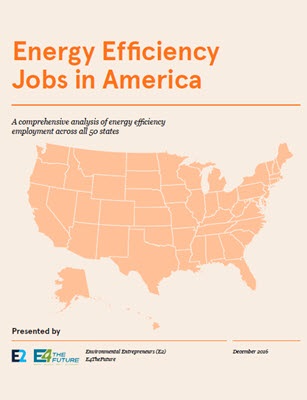
Energy Efficiency Jobs in America – 2016
By Environmental Entrepreneurs (E2) and E4TheFuture – December 2016
Energy efficiency does more than cut waste and save dollars. It employs 1.9 million Americans, by far the largest sector in the U.S. clean economy. This report highlights the top states. It also includes detailed state fact sheets and specific numbers of energy efficiency jobs on city, county, legislative and congressional district levels – data not available previously.
The report is based on data from the U.S. Bureau of Labor Statistics and the U.S. Department of Energy, as well as a comprehensive survey of tens of thousands of businesses across the country. See a jobs per capita comparison.
-
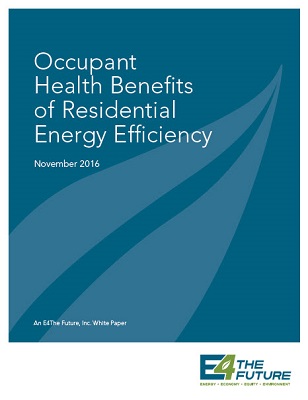
Occupant Health Benefits of Residential Energy Efficiency
By Tohn Environmental Strategies team, with Foreword by E4TheFuture – November 2016
The paper builds understanding and access to relevant data that can support inclusion of health impacts as a public benefit of energy efficiency. The 35-page paper:
- reviews and summarizes research studies of residential energy efficiency and related ventilation upgrades
- discusses ways that programs have monetized occupant health co-benefits
- identifies where research gaps exist, and/or where research can be improved and leveraged
- provides an overview of innovative programs that combine energy efficiency and health-focused home repairs
E4TheFuture invites readers of this paper to collaborate on integrated approaches to improving indoor air quality of homes across the U.S. and beyond. See a two-page summary.
-

Harnessing the Power of Tradable Credit Markets for Energy Efficiency
E4TheFuture Case Study – September 2016
Connecticut has successfully incentivized energy efficiency project development through market-based tradable credits. The state has quietly stimulated projects for its benefit as well as for EE Providers and their clients.
The CT RPS Class III program has effectively harnessed the market structure originally designed to drive private investment in renewable power generation. This case study reviews the steps for trading energy efficiency credits in Connecticut.
Many other states would benefit from setting up or participating in similar programs.
-
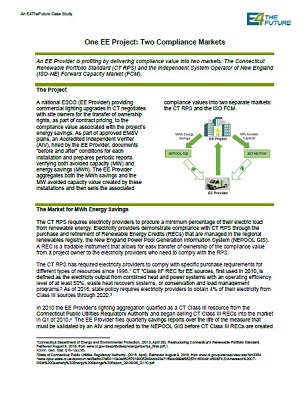
One EE Project: Two Compliance Markets
E4TheFuture Case Study – September 2016
A national ESCO is profiting by delivering compliance value into two markets: Connecticut’s Renewable Portfolio Standard (CT RPS) and the Independent System Operator of New England’s Forward Capacity Market.
This energy efficiency project is an example of a private sector entity registering an aggregation of energy efficiency measures and selling both the related MWh energy savings and the MW electric capacity. The two commodities are documented in two different tracking systems due to the evolution of public policy; however, the opportunity provided to energy efficiency vendors by similarly diverse markets could be tracked via a single system in other states.
-
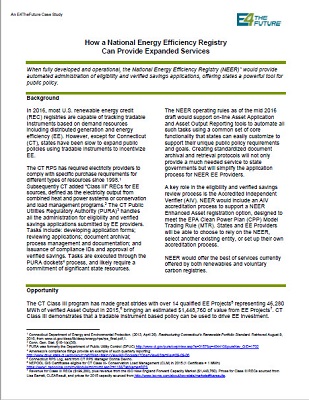
How a National Energy Efficiency Registry Can Provide Expanded Services
E4TheFuture Case Study – September 2016
When fully developed and operational, the National Energy Efficiency Registry (NEER) would provide automated administration of eligibility and verified savings applications, offering states a powerful tool for public policy.
Included: An illustration of how NEER administration would streamline the eligibility and verified saving application process for both Client Jurisdictions and EE Providers.
Disclaimer: This case study was prepared by, and is the sole responsibility of, E4TheFuture. E4TheFuture is not a National Energy Efficiency Registry (NEER) “project partner” and does not represent the U.S. DOE, the six states, and/or partners The Climate Registry or NASEO in this document. As such, the views expressed are strictly those of E4TheFuture and may not precisely match information provided by the above-referenced project, participating states, or project partners.
-

Regional Energy Markets: Do Inconsistent Governance Structures Impede U.S. Market Success?
Body of paper authored by Synapse Energy Economics, Inc. – July 2016
The paper presents current research about the role of new technologies and distributed resources in wholesale U.S. electricity markets. E4TheFuture commissioned Synapse Energy Economics to review energy markets’ governance by Regional Transmission Organizations and Independent System Operators.
- A clear summary identifying the governance structure in each of the seven energy markets overseen by an ISO/RTO
- Analysis of the impact of governance on the extent to which the full range of energy resources can participate in wholesale markets
- A demonstration of the inconsistent approach to governance and/or market inclusion of particular energy resources
- Appendices containing historical context and a summary of RTO/ISO treatment of energy efficiency, demand response and distributed generation resources in transmission planning
E4TheFuture intends that the paper will help inform policy-focused organizations who wish to work together to improve governance structures and market rules.
-
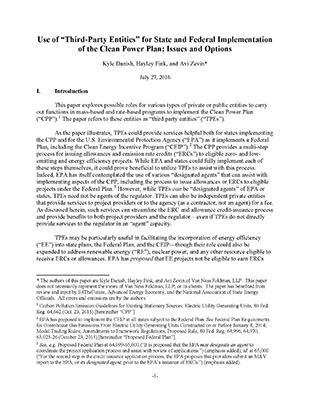
Use of “Third-Party Entities” for State and Federal Implementation of the Clean Power Plan: Issues and Options
White paper by Kyle Danish, Hayley Fink, and Avi Zevin of Van Ness Feldman, LLP – July 2016
This paper explores possible roles for various types of private or public entities to carry out functions in mass-based and rate-based programs to implement the Clean Power Plan (“CPP”). The paper refers to these entities as “third party entities” (“TPEs”).
As the paper illustrates, TPEs could provide services helpful both for states implementing the CPP and for the U.S. Environmental Protection Agency as it implements a Federal Plan, including the Clean Energy Incentive Program (“CEIP”).
This paper does not necessarily represent the views of Van Ness Feldman, LLP, or its clients. The paper has benefited from review and input by E4TheFuture, Advanced Energy Economy, and the National Association of State Energy Officials. All errors and omissions are by the authors.
-
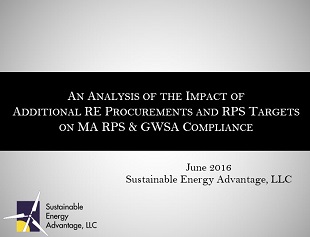
An Analysis of the Impact of Additional RE Procurements and RPS Targets on MA RPS & GWSA Compliance
Authored by Jason Gifford, Sustainable Energy Advantage, LLC – June 2016
Prepared on behalf of E4TheFuture for Massachusetts Sierra Club’s use in educating legislators in advance of the June 30 vote on energy legislation. Concise analysis and demonstration of why/how: 1) policy to increase renewable energy procurement should be balanced with policy to increase renewable energy demand, and 2) to count additional procured supply toward Global Warming Solutions Act limits, Renewable Portfolio Standard targets must be increased so that RECs are retained.
-

Energy Savings Prediction Methods for Residential Energy Efficiency Upgrades
Authored by Robin LeBaron, Kara Saul-Rinaldi, Steve Cowell – Feb/Mar 2016
This is a response to the U.S. Department of Energy’s Request for Information on “how to improve savings prediction methods for residential energy efficiency upgrades.” The authors propose a way to incorporate integrating modeled and metered savings into residential energy efficiency upgrades. Essential policy considerations are addressed such as risk, upfront costs, access to utility data, potential for gaming, and customer equity.
-
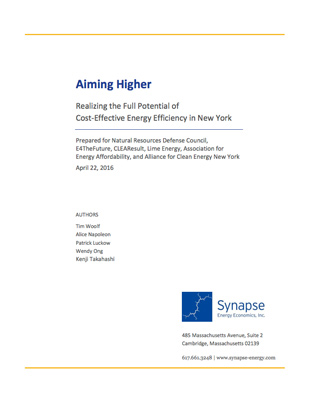
Aiming Higher: Realizing the Full Potential of Cost-Effective Energy Efficiency in New York
Authored by Synapse Energy Economics, Inc. – Apr 2016
Prepared for Natural Resources Defense Council, E4TheFuture, CLEAResult, Lime Energy, Association for Energy Affordability, and Alliance for Clean Energy New York.
From the introduction: “Despite New York’s aggressive clean energy goal of obtaining half its electricity from renewable sources by 2030, recent New York Public Service Commission (PSC or Commission) decisions call for energy efficiency targets to remain at current levels into the near to intermediate future. In the Clean Energy Standard (CES) White Paper, DPS Staff assumed annual incremental energy efficiency savings of 2,227 gigawatt-hours (GWh) statewide through 2030. This level of savings translates into a flat 1.4 percent annual savings as a percent of 2014 sales throughout the period of analysis.
This level of savings is far below what is possible from a technical and economic standpoint, and also relative to what nearby states are already achieving. Energy efficiency is New York’s most cost-effective resource, and yet the state is at risk of losing out on much of its potential in coming years.”
-
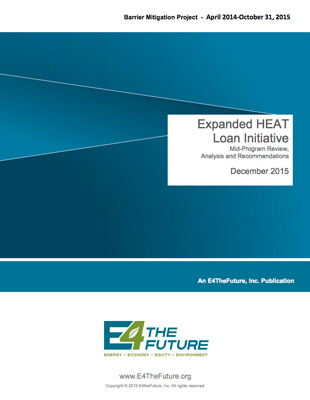
Expanded HEAT Loan Initiative / Barrier Mitigation Project: Mid-Program Review
Dec 2015
This paper presents an update on progress addressing key barriers blocking many Massachusetts consumers from completing energy efficiency work on their homes. The Expanded HEAT Loan Initiative has proven to be valuable in removing barriers and facilitating investments. The report includes:
- A clear explanation of the issues
- Description of measure types new to the Mass Save® program
- Status of installations including lessons learned
- E4TheFuture’s recommendations for further improvements
Although Massachusetts leads the nation in delivering energy efficiency programs, much work remains before all homes and buildings are operating at top efficiency.
-
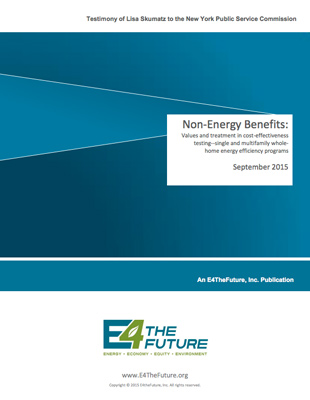
New York Testimony on Non-Energy Benefits
Authored by Dr. Lisa Skumatz — Sept 2015
The NY Public Service Commission sought information about non-energy benefits (NEBs) as part of their Reforming Energy Vision (REV) proceeding. E4TheFuture commissioned testimony for whole-home single and multifamily energy efficiency programs that demonstrates relevance for New York. This document by Dr. Lisa Skumatz provides:
- A lucid explanation of NEBs—types and importance
- Why benefit-cost analyses excluding NEBs are only half what they should be
- Recommended NEB Values as Multipliers on Bill Savings
- “Adders” – societal benefits associated with low income programs
- Literature review on state of the art for multifamily programs, gas vs. electric programs, and specific measures
Dr. Skumatz’s testimony provides values useful in the near term to update and reduce the bias in benefit-cost tests for efficiency programs. NEBs approximately double program “benefits” and the value of the associated benefit-cost ratio.

